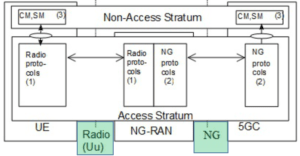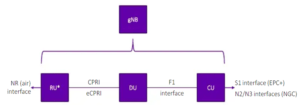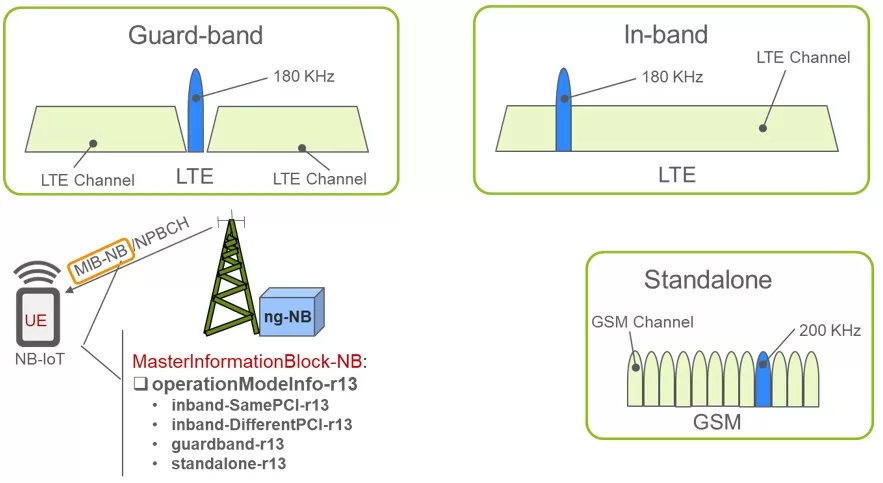Introduction
For 5G networks to be able to meet the performance requirements demanded by applications such as extreme mobile broadband and long-range massive MTC, Current RAN architecture needs a transformation to improve network flexibility.
The transformation includes different points, one of them is splitting between user-plan and control plan, Midhaul Link, and new Radio protocols to be added like SDAP (Service Data Adaptation Protocol).
What is NG-RAN?
NG- RAN is Next Generation Radio Access Network.
NG-RAN is a part of the 3GPP 5G system; responsible for providing Radio Access to 5G networks. NG-RAN Node can be either a gNB or an NG-eNB according to the 3GPP TS 38.300 specifications.
gNB provides 5G NR access to the users by providing NR control and user plane protocol termination toward the user equipment side.
NG-eNB provides LTE Radio access to the users or provides E-UTRA control and user plane protocol termination towards the user equipment side.
General Principles for NG-RAN
The general principles guiding the definition of NG-RAN architecture as well as the NG-RAN interfaces are the following:
• Logical separation of signaling and data transport networks.
• NG-RAN and 5GC functions are fully separated from transport functions.
• RRC connection mobility is fully controlled by the NG-RAN.
• The NG-RAN interfaces are defined along with the following principles:
1. The functional division across the interfaces have as few options as possible.
2. Interfaces are based on a logical model of the entity controlled through this interface.
3. One physical network element can implement multiple logical nodes.
5G General Architecture

Source: 3GPP
The NG-RAN consists of a set of gNBs connected to the 5GC (5G core network) via the NG interface. The gNBs are interconnected through the Xn interface.
The protocols over Uu and NG interfaces are classified into user plane protocols and control plane protocols.
• User plane protocols are responsible for the actual PDU Session service which carries user data through the AS (access stratum).
• Control plane protocols are responsible for the PDU Sessions and connection between UE and the NW.
5G NG-RAN architecture

Source: 3GPP
A gNB may consist of a gNB-CU (Central Unit) and one or more gNB-DUs (Distribution Unit).
A gNB-CU and the gNB-DU units are connected with F1 logical interface. One gNB-DU is connected to only one gNB-CU.
NG, Xn, and F1 are logical interfaces.
5GC (5G Core) Network architecture offers many functions including network slicing to serve different customer requirements. It provides a distributed cloud, SDN (Software Defined Networking) & NFV (Network functions virtualization).
5G RAN functional decomposition

Source: 5G RAN Architecture Evolution
• gNB Central Unit (gNB-CU): a logical node consists of RRC, PDCP and SDAP protocols of the gNB or RRC and PDCP protocols of the en-gNB that controls the operation of one or more gNB-DUs.
• gNB Distributed Unit (gNB-DU): a logical node consists of RLC, MAC and PHY layers of the gNB or en-gNB, and its operation is partly controlled by gNB-CU.
One gNB-DU supports one or multiple cells and One cell is supported by only one gNB-DU.
• F1 Interface: Where fronthaul is the network between RRU (Remote Radio Unit) and DU (CPRI and eCPRI interfaces), midhaul is the network between DU and CU (F1 interface).
F1 Interface

F1 Interface
The F1 interface supports signaling exchange and data transmission between the endpoints, separates Radio Network Layer and Transport Network Layer, and enables the exchange of UE-associated and non-UE-associated signaling. In addition, F1 interface functions are divided into F1-C and F1-U functions.
F1-C (Control Plane) Functions:
• F1 Interface Management Functions: Like F1 setup, gNB-CU Configuration Update and gNB-DU Configuration Update.
• System Information (SI) Management Functions: The gNB-DU is responsible for the scheduling and broadcasting of system information.
• F1 UE Context Management Functions: the establishment and modification of the necessary UE context.
• RRC Message Transfer Function: the transferring of RRC messages from the gNB-CU to the gNB-DU, and vice versa.
F1-U (User Plane) Functions:
• Transfer of User Data: It transfers user data between gNB-CU and gNB-DU.
• Flow Control Function: It controls the downlink user data towards the gNB-DU.
Benefits of RAN Spilt Architecture
• Flexible HW implementations decrease the total cost of ownership (TCO).
• A split architecture (between CU and DU) allows for coordination for performance features, load management, real-time performance optimization, and enables NFV/SDN.
• Configurable functional splits enable adaptation to different use cases, such as variable latency on transport.
References:
• 3GPP TS 38.401 version 15.2.0 Release 15.
• 5G System Design, 5G Procedure, RAN Architecture, and Protocol.
• River Publishers, 5G NG RAN.
• ITU-T Transport network support of IMT-2020/5G.
• 5G Network Architecture White Paper.













